This is going to be a bit rambling, because I'm trying to tell about three stories at once and they all interlock. My apologies in advance.
The classic VW engine is a "wet sump" engine; that is, the oil pools in the bottom of the crank case. The opening in the bottom of the sump (see previous post) is covered by a sump plate, upon which rests an oil screen. When the plate is installed, the oil screen rests on top of it (out sight inside the oil sump). The screen is not a filter; it's just there in case some chunk of metal falls into the oil sump, it doesn't get sucked into the oil pump and jam the gears.
Since the engine doesn't have an oil filter by design, there's nothing to remove crud from the oil as in modern engines. In the case of old-fashioned oils, which were just oil, all the stuff would fall to the bottom of the crank case. With modern detergent oils, the dirt and impurities remain suspended in the oil, but any sludge and grid still ends up on the bottom of the crank case. The result in this engine is the same; a lot of stuff that you dont' want hanging around your engine ends up lying on the bottom of the engine (a lot of it ends up in the screen or on top of the sump plate.
So now we come to the sump plate itself. Here are a couple of
examples of them:
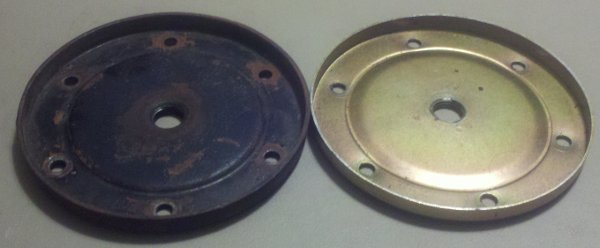
The six holes on the rim fit over the six studs that were discussed in
the previous post. In the center is a threaded hole for the oil drain
plug. The one on the left is probably an original, the one on the
right is a recent aftermarket copy (it's made from much thinner
steel but at least it doesn't have rust problems). When you install
it, the screen goes in the sump, the plate goes on the studs (with
proper gaskets), then the drain bolt goes in the center of the plate
like so:
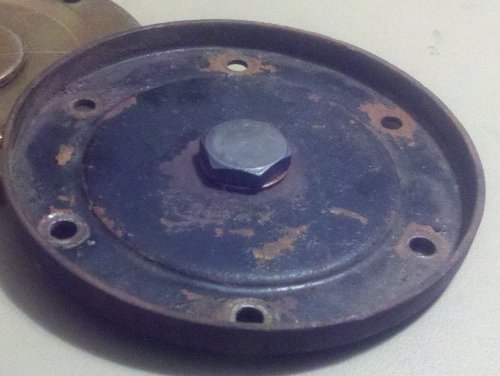
That's the background. My engine has always leaked oil. Like many engines put together not very well, it leaked oil from multiple places and so it's really hard to track down where. For the longest time, I've suspected that the oil sump is one of the places it's leaking from. There are at least two problems with the oil sump plate that was on the car when I got it (the shiny one above). One problem is that it's thin enough so that it's not entirely flat, so it doesn't seal entirely well against the oil sump itself. The second problem is that I wasn't able to get the oil drain bolt to seal entirely. This was because I couldn't put enough torque on it to seal properly.
The sump plate is sheet metal, which is too thin to hold threads in
a hole. The sump plates are thickened so that they will hold threads;
here's the upper surface of both plates:

The new one has a plate welded to it in the center that allows a hole
to be drilled and tapped for the oil drain bolt. The old one had the
hole sort of extruded up from the sheet metal and the threads cut into
the extrusion:
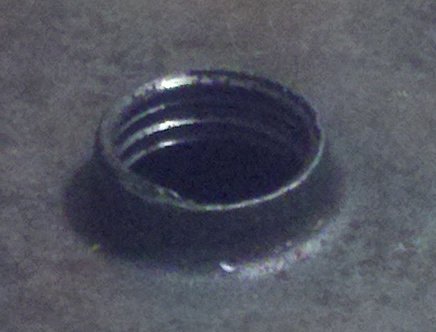
The aftermarket sump plates really don't have enough thread to be able
to put enough torque on the oil drain bolt to seal well. I put as
much torque as I felt I could on mine, even with a new (aftermarket)
sump plate, and it still leaked slightly around the drain bolt. Later
on in my working on the car, I got the plate on the left from a guy
selling old VW parts. The threads might hold up to the torque, but
the plate is rusty and not very flat, so I don't think it will solve
the problem.
The proper procedure for changing the oil with a sump plate as above is as follows. You take the big oil drain bolt out of the center of the sump plate, the oil drains out. Then you remove the sump plate and oil screen, and CLEAN them (to remove the chunks of stuff that remain at the bottom of the oils sump--remember?). This is very important; there's potentially stuff in the screen and on the plate that you don't want to circulate back into your engine; the whole point is to have the engine filled with clean oil. If your engine is fairly healty and you change your oil frequently, it's probably Ok to only remove the sump plate every other oil change to clean it.
HOWEVER--at some point VW realized that people (owners or mechanics or
both, I guess) were getting lazy about cleaning the filters. People
were getting into the habit of draining the oil but not removing or
cleaning the screens and sump plates at all. They'd just drain the
oil, put the drain bolt back in, put fresh oil in, then go. This
meant that sludge was getting into the engines and shortening their
life. So I believe for the several years that VW was making engines,
this is what the sump plates looked like:
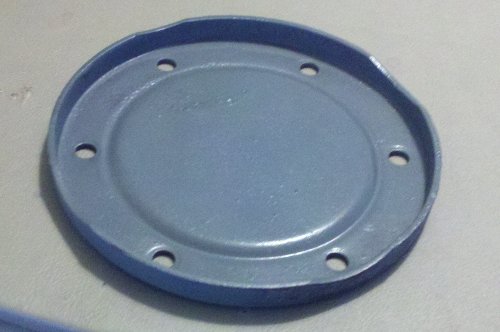
There's no drain bolt at all. The only way to get the oil out is to
remove the plate and screen, so you have to take it out, and at that
point you might as well clean them before you put them back in.
I got that plate a few years ago from yet another guy selling old VW
stuff. Personally, don't much care about the oil drain bolt vs. not.
However, this plate was the original thicker metal, and it's very very
flat; flatter than any of the other sump plates I have. (That's good
because it's likely to seal against the sump better.). To get it
ready to install, I sanded the sleaing surface so that it was even
flatter.

My plan had been to install that plate ASAP...but...as pointed out in
the previous post, three of the studs were loose in my engine. So I
was trying to take the sump plate out as little as possible (which
might have gotten me into a bit of trouble; I'll talk about this in
another post). I didn't want to go to the no-drain-plug plate,
because that means I'd have to take the whole plate off for every oil
change, and that would put more wear on the stud holes. However, a
couple of weeks ago I got the stud problem fixed (previous post), so
as of now, I'm on the oil drain system that the engine was probably
equipped with in the first place:
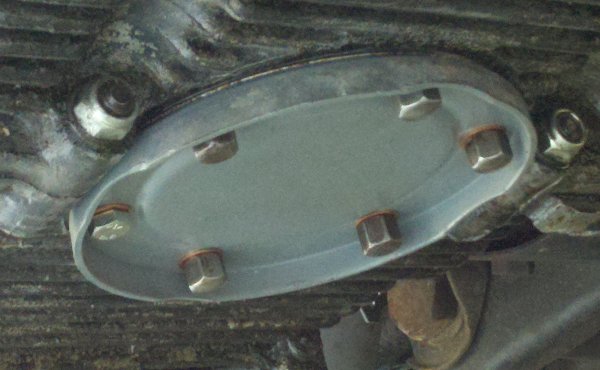
Sharp-eyed readers might notice that the last photo was actually
taken before I fixed the studs; one of the cap screw on a stud is
actually a bolt of the same thread size. You can tell by the depth of
the head. The cap nuts that go on the studs are a full depth nut plus
an entire cap that covers the end of the stud. The middle right on
this photo is a oil sump cap nut:
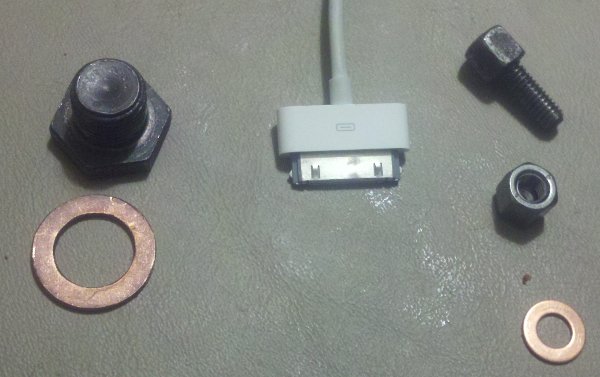
The upper right is a cap nut stick on a stud; that was one that had
been holding my sump plate on. The lower right is a copper washer
that is used to seal the cap nuts against the sump plate. On the left
is a drain bolt and a copper sealing washer for it. (And in the
middle is an iPhone connector for scale.)